 Since I read C. G. Jung’s essay, Flying Saucers: A Modern Myth of Things Seen in the Skies years ago I became interested in the change in millennia, particularly after my mother died in the mid 1990s and I had a series of extraordinary dreams for a period of about two years. We were, of course, at the same time approaching the end of the millennium and there was a good deal of hysteria (Y2K) and hubris/denial (the Dow Jones averages will go up to 35,000 and Jesus is coming!) – classic symptoms of Fin de Siècle. Jung wrote in the introduction to his essay that although few people would hear him, it was his duty to prepare those few who would hear for coming events which are in accord with the end of an era. “As we know from ancient Egyptian history,” he wrote, “they are manifestations of psychic changes which always appear at the end of one Platonic month and at the beginning of another. Apparently they are changes in the constellation of psychic dominants. . . . (etc., etc.) This transformation started in the historical era and left its traces first in the passing of the aeon of Taurus into that of Aries, and then of Aries into Pisces, whose beginning coincides with the rise of Christianity. We are now nearing that great change which may be expected when the springpoint enters Aquarius.”
Since I read C. G. Jung’s essay, Flying Saucers: A Modern Myth of Things Seen in the Skies years ago I became interested in the change in millennia, particularly after my mother died in the mid 1990s and I had a series of extraordinary dreams for a period of about two years. We were, of course, at the same time approaching the end of the millennium and there was a good deal of hysteria (Y2K) and hubris/denial (the Dow Jones averages will go up to 35,000 and Jesus is coming!) – classic symptoms of Fin de Siècle. Jung wrote in the introduction to his essay that although few people would hear him, it was his duty to prepare those few who would hear for coming events which are in accord with the end of an era. “As we know from ancient Egyptian history,” he wrote, “they are manifestations of psychic changes which always appear at the end of one Platonic month and at the beginning of another. Apparently they are changes in the constellation of psychic dominants. . . . (etc., etc.) This transformation started in the historical era and left its traces first in the passing of the aeon of Taurus into that of Aries, and then of Aries into Pisces, whose beginning coincides with the rise of Christianity. We are now nearing that great change which may be expected when the springpoint enters Aquarius.” The Platonic months are two-thousand year periods which run in sequence through twelve signs to a complete Sun cycle of approximately 24,000 years. The Age of Pisces, mentioned by Jung above, was marked by the Star over
 The Platonic months as I understand it themselves alternate between introvert and extravert, or yin and yang if you prefer, giving the passing eras a sense of alternating chirality (“right-handedness” and “left-handedness”) you might say, and forming a kind of cosmic turbine. Pisces, the receding age, was a yin or introverted age (marked by a water sign and the ascent of the Earth Mother in
The Platonic months as I understand it themselves alternate between introvert and extravert, or yin and yang if you prefer, giving the passing eras a sense of alternating chirality (“right-handedness” and “left-handedness”) you might say, and forming a kind of cosmic turbine. Pisces, the receding age, was a yin or introverted age (marked by a water sign and the ascent of the Earth Mother in
The Ascending Age of Aquarius is a yang or extraverted age, (marked by air and in Jung’s essay, visions of UFOs). At the turning of Pisces, Christ represented the Introverted Force while Caesar represented the Extraverted Force. The Christ/Caesar paradigm will flip in Aquarius and the Caesar figure should ascend (the age is marked by the rise of the Titan – a governor - did somebody say Arnold?), while the Christ/Introverted Avatar will fall into remission and disrepair.
essay, visions of UFOs). At the turning of Pisces, Christ represented the Introverted Force while Caesar represented the Extraverted Force. The Christ/Caesar paradigm will flip in Aquarius and the Caesar figure should ascend (the age is marked by the rise of the Titan – a governor - did somebody say Arnold?), while the Christ/Introverted Avatar will fall into remission and disrepair.
This is in opposition to popular notions of the Age of Aquarius, which come largely from the pop culture of the 1960s in which hippies were compared to the early Christians. Canadian writer Robertson Davies, who cited Jung in much of his writing, pointed out that the Aquarian Age would be an Authoritarian Age (and if the hippie movement resembled the early Christians it was as a waning force – See Davies’ essay “What Will the Age of Aquarius Bring?” in his book, One-Half of Robertson Davies). Technically, in the Greek configuration ofAquarius, the traditional role of water pourer - curing, healing and creative awakening - the feminine experience has been usurped by a male, Ganymede.
 I’ve looked at a lot of music, literature and paintings from over the last millennia and most all significant European painting represents a quality of consciousness which rises from the earth to the sky, yin to yang. But the very most significant
I’ve looked at a lot of music, literature and paintings from over the last millennia and most all significant European painting represents a quality of consciousness which rises from the earth to the sky, yin to yang. But the very most significant The Magic Flute. Ingmar Bergman’s movie version (1973) illustrates the European journey from the Earth Mother in her dark phase – Kali, the Death Mother – to the cosmic masculine principle, and thus went the Western world with Mozart in 1791. I see the nature of the age ahead as one in which East meets
The Magic Flute. Ingmar Bergman’s movie version (1973) illustrates the European journey from the Earth Mother in her dark phase – Kali, the Death Mother – to the cosmic masculine principle, and thus went the Western world with Mozart in 1791. I see the nature of the age ahead as one in which East meets 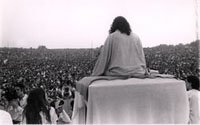 West (“One world, many paths,” in the phrase of the Woodstock guru Swami Satchidananda) in the immediate future and the Introvert/Extravert figures emerging as both likely Europeans but both emerging in the New World – the North American continent - and both beginning to reveal themselves perhaps in the near future.
West (“One world, many paths,” in the phrase of the Woodstock guru Swami Satchidananda) in the immediate future and the Introvert/Extravert figures emerging as both likely Europeans but both emerging in the New World – the North American continent - and both beginning to reveal themselves perhaps in the near future.
 I recently posted some thoughts on a
I recently posted some thoughts on a
From the horse ascending to the sky from its own corpse in 1930 (“William Tell”) to a Buddhist monk in orange robes descending from a horse in the sky 40 years later (“The Second Coming of Christ”), the pictures easily yield to archetypal dream analysis and tell one story. The horse is important. It is Pegasus, the harbinger of Aquarius. Pegasus takes to the sky and kicks the mountain, freeing the curing and creative waters of a new age. Dali was certainly aware of this symbolism, as there were no social conventions opposing the occult and the zodiac as there are today in the West, and artists and even more conventional architects were knowledgeable about the Inner Life and often incorporated zodiac symbolism in their work. Dali was heavily influenced by Jung and his style of painting, which he called Paranoid Critical Method is clearly an application of Active Imagination, a strategy of dream analysis pioneered by Jung.
Thinking of the Piano Man, I began looking back at some old Dali and Magritte paintings from the 1930s, and saw that the white grand piano was the key to metamorphic transformation in Dali’s work. In a nutshell, this is what I discovered. There were three alchemical periods (in which artists delved into the occult and searched the Unconscious for inner truths) in the last century and they are all interrelated: the first, consisted of William Butler Yeats, Khrishnamurti, Madame Blavatski and the Theosophists as core influences in the late 1800s.
Dali’s work. In a nutshell, this is what I discovered. There were three alchemical periods (in which artists delved into the occult and searched the Unconscious for inner truths) in the last century and they are all interrelated: the first, consisted of William Butler Yeats, Khrishnamurti, Madame Blavatski and the Theosophists as core influences in the late 1800s.
The second, the Surrealists in the 1930s, consisting of artists Salvador Dali, Rene Magritte and Max Ernst as core members. There was a third fleeting but vastly more influential group; the small grouping of John  Lennon and his friend Stu Sutcliffe, the English art students who started The Beatles, and the German avant garde photographer and artist friends, especially the photographer Astrid Kirchherr (who gave them the Beatle hair cuts) and the photographer Klaus Voorman, whom they befriended in Germany before The Beatles became fully formed.
Lennon and his friend Stu Sutcliffe, the English art students who started The Beatles, and the German avant garde photographer and artist friends, especially the photographer Astrid Kirchherr (who gave them the Beatle hair cuts) and the photographer Klaus Voorman, whom they befriended in Germany before The Beatles became fully formed.
All three of these groups are connected by C.G. Jung. Jung wrote about the Blavatsky/Khrishnamurti grouping as a new “fledgling religion” in the West and Jung and the Irish poet Yeats are linked through alchemy studies – (see Yeats Mythologies for intimate writings on the Alchemical Rose and his doings with the occult). In the middle group Magritte and Dali are symbiotes – the same symbols occur in both their work at the same period.
 Dali’s work seems directly influenced by Jung and Wolfgang Pauli, particularly in their study on nuclear explosion and the shattering of mind-matter, as a turning point in world history. Dali’s work in the 1950s and later often pictured things in exploding molecular parts. The nuclear explosion is a turning point in Dali’s work, but what follows is not his best work, and much of it seems to be applied from the Jung/Pauli theory that the first splitting of the atom was a critical juncture in the transformation of human consciousness. Dali’s later work, much of it illustrated with the Alchemical Rose and alchemical animals, seems derived as well from Jung and Yeats’ thinking with some startling exceptions.
Dali’s work seems directly influenced by Jung and Wolfgang Pauli, particularly in their study on nuclear explosion and the shattering of mind-matter, as a turning point in world history. Dali’s work in the 1950s and later often pictured things in exploding molecular parts. The nuclear explosion is a turning point in Dali’s work, but what follows is not his best work, and much of it seems to be applied from the Jung/Pauli theory that the first splitting of the atom was a critical juncture in the transformation of human consciousness. Dali’s later work, much of it illustrated with the Alchemical Rose and alchemical animals, seems derived as well from Jung and Yeats’ thinking with some startling exceptions.
With The Beatles, only Sutcliffe and Lennon (and to some extent George Harrison) appeared deeply interested in the artist’s Unconscious and the occult. On the cover of the famed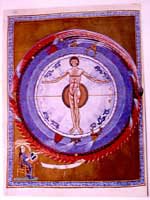 Sgt. Peppers album are Sutcliffe, Aldous Huxley, Aleister Crowley, Sri Yuktewar Gigi, Sri Mahavatara Babajii and a few other gurus. Top row center is C.G. Jung. The final words of The Beatles as a group was, “Here comes the Sun King,” which should at least evoke some curiosity about the shift between passing age and ascending age at what was conceivably the century’s strangest moment.
Sgt. Peppers album are Sutcliffe, Aldous Huxley, Aleister Crowley, Sri Yuktewar Gigi, Sri Mahavatara Babajii and a few other gurus. Top row center is C.G. Jung. The final words of The Beatles as a group was, “Here comes the Sun King,” which should at least evoke some curiosity about the shift between passing age and ascending age at what was conceivably the century’s strangest moment.
 The Beatles and the portion of the Sixties zeitgeist which relates to these issues is very important as the group’s rise reflects a change in world culture due to what Jung called the ascent of “the American tempo.” It was populism at its peak and perhaps at its possible best. In earlier art and culture movements in the early 1900s and even just before the war, well-bred and educated people like Yeats and Aldous Huxley could influence a gentry which held sway in politics. And in earlier times a folk ditty would float among the peasants for 200 years before it got to Johan Sebastian Bach.
The Beatles and the portion of the Sixties zeitgeist which relates to these issues is very important as the group’s rise reflects a change in world culture due to what Jung called the ascent of “the American tempo.” It was populism at its peak and perhaps at its possible best. In earlier art and culture movements in the early 1900s and even just before the war, well-bred and educated people like Yeats and Aldous Huxley could influence a gentry which held sway in politics. And in earlier times a folk ditty would float among the peasants for 200 years before it got to Johan Sebastian Bach.
No longer. The post-war period brought primal American folk influences – Little Richard, Hank Williams, Elvis – direct, unadorned and without interpretation to a vast world youth consumer mass-market, creating a global youth culture. Likewise in the Sixties. The influence of this on world culture has been enormous. The context is largely forgotten now if not to say repressed by a countervailing political culture, but at one moment in 1968 as public opinion turned to rage against the war in Vietnam and turmoil and riots racked cities and campuses around the world, John Lennon, in white suit and lengthy beard, penning a peace anthem for demonstrations in Toronto, was perhaps the most important man in the world. The change it brought has been enormous. The Maharishi Mahesh Yogi may have been freaky and startling to suburban America in 1967, but today, the Dalai Lama is as popular and uncontroversial a figure as Mother Teresa.
As far as I can see, these three periods belong together, but to date as far as I know, no one has put them together. Interested parties might read William Strauss & Neil Howe’s great book on history and generational identity, The Fourth Turning: What the Cycles of History Tell Us About America’s Next Rendevouz with Destiny, to see how historical periods alternate in Introverted and extroverted manner. These three periods fit in the Strauss/Howe pattern of alternating historical cycles in the Introverted arcs.
What I find most interesting is that the Theosophists and the Surrealists in hindsight can be seen as prelude to the atomic bomb, first exploded in July, 1945. The rise of The Beatles (only to the point of Sgt. Peppers and the journey to
For example:
 This picture by Salvador Dali is similar to William Butler Yeats’ Aquarian messiah in the short story “The Gift of the Magi” in the book Mythologies – it tells of the Aquarian as a Unicorn born to a prostitute in a brothel in
This picture by Salvador Dali is similar to William Butler Yeats’ Aquarian messiah in the short story “The Gift of the Magi” in the book Mythologies – it tells of the Aquarian as a Unicorn born to a prostitute in a brothel in 
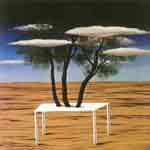 the three Aquarian figure is virtually unknown.) In Yeats’ story the “Magi” are three old Irish fishermen who lead the protagonist to the Unicorn. The three male avatars – Jesus and Magi, Abraham and the three Visitors – are marked here by three trees (Magritte has the three trees as well). The three trees as well suggest Yggdrasil, The World Tree, and its Three Realms which contain the Nine Worlds of Northern European folklore. Jung showed interest in Yeats and his group (including the prescient actress Maude Gunn, I would think). Yeats was deeply influenced by alchemy and wrote of the Alchemical Rose throughout “Mythologies.”
the three Aquarian figure is virtually unknown.) In Yeats’ story the “Magi” are three old Irish fishermen who lead the protagonist to the Unicorn. The three male avatars – Jesus and Magi, Abraham and the three Visitors – are marked here by three trees (Magritte has the three trees as well). The three trees as well suggest Yggdrasil, The World Tree, and its Three Realms which contain the Nine Worlds of Northern European folklore. Jung showed interest in Yeats and his group (including the prescient actress Maude Gunn, I would think). Yeats was deeply influenced by alchemy and wrote of the Alchemical Rose throughout “Mythologies.”
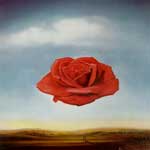 Dali’s “Meditative Rose” (1958). This image, symbolizing the “rosy cross” was key to Yeats. It appears in much of Dali’s work in the 1950s and later as the symbol of Christ and the Baby Jesus. This clearly seems derived from Yeats.
Dali’s “Meditative Rose” (1958). This image, symbolizing the “rosy cross” was key to Yeats. It appears in much of Dali’s work in the 1950s and later as the symbol of Christ and the Baby Jesus. This clearly seems derived from Yeats.
(photo of Dali’s Temptation of St. Anthony)
Jung and others speak of Pegasus as the harbinger of the ascending Age of Aquarius. The flying horse begins to rise out of Dali’s work in 1930 and it rises out of a grand piano. This is “The Temptation of St. Anthony” (1946). I would think that this is derived as well although it is an interesting painting. This “Temptation” is an Aquarian vision with Pegasus leading Rome (the spirit center of Europe in the waning Age of Pisces) on elephants to the sky and to a new place in a desert which, in the context of his other paintings and interests in this period appears to be Texas (he painted this in the United States). Dali would know from Jung and others that Aquarius is an air age in the zodiac configuration.
(1946). I would think that this is derived as well although it is an interesting painting. This “Temptation” is an Aquarian vision with Pegasus leading Rome (the spirit center of Europe in the waning Age of Pisces) on elephants to the sky and to a new place in a desert which, in the context of his other paintings and interests in this period appears to be Texas (he painted this in the United States). Dali would know from Jung and others that Aquarius is an air age in the zodiac configuration.
But what is most interesting psychologically in Dali and Magritte is their work in the 1930s. It is dense, broody, almost oppressive. The pictures come purely from the unconscious and are full of foreboding. Most interesting, key elements are the grand piano (particularly in Dali) and the alchemical lion.
 Here is an old catalog picture of the alchemical lion from earlier centuries – the vegetation spirit of the earth which devours the sun. Look below how this figure enters into the dense work of Dali and Magritte in the 1930s.
Here is an old catalog picture of the alchemical lion from earlier centuries – the vegetation spirit of the earth which devours the sun. Look below how this figure enters into the dense work of Dali and Magritte in the 1930s.
This painting by Dali, “The Feeling of Becoming” in 1930 illustrates something rising from the unconscious “beyond the veil” as the shadow of the alchemical lion is approaching.
illustrates something rising from the unconscious “beyond the veil” as the shadow of the alchemical lion is approaching.
This one by Dali in the same period (1931) is called “Diurnal Illusion: the Shadow of a Grand Piano Approaching.” It shows the same foreboding – fear of something ahead rising from the Unconscious.
This is an extraordinary picture titled William Tell (1930).  The Adam and Eve figures on the bottom suggest Primal Yin and Yang – they appear in a later picture sending the two out of the Garden. The tomb stone thing to the right with water flowing from it suggests new life coming from the unconscious (The Land of the Dead begins to feature prominently in Dali’s work hereafter). The vision rising from the primal Adam and Eve is of a man sitting at a grand piano with dual nature (he has two heads attached to each other, like a Siamese twin); the one a contemporary piano player, the other the alchemical lion. Pegasus rises from a dead horse carcass on top of the grand piano. This is the archetype of
The Adam and Eve figures on the bottom suggest Primal Yin and Yang – they appear in a later picture sending the two out of the Garden. The tomb stone thing to the right with water flowing from it suggests new life coming from the unconscious (The Land of the Dead begins to feature prominently in Dali’s work hereafter). The vision rising from the primal Adam and Eve is of a man sitting at a grand piano with dual nature (he has two heads attached to each other, like a Siamese twin); the one a contemporary piano player, the other the alchemical lion. Pegasus rises from a dead horse carcass on top of the grand piano. This is the archetype of
Life behind the curtain – the unconscious – presents Primal Yin and Yang – and newly manifested Adam and Eve sent to the world under the shadow of Alchemical Lion in a continuation of the last picture, this one named, “The Old Age of William Tell.” (1931).
manifested Adam and Eve sent to the world under the shadow of Alchemical Lion in a continuation of the last picture, this one named, “The Old Age of William Tell.” (1931).
 Another grand piano in 1931 with a door open to the Unconscious and a woman (Anima) figure outside. I understand the six “Lenin” heads to be the equivalence of the “six grandfathers” in Black Elk – the six male figures being the six male signs of the zodiac or the half of the Universe which is Yang. The waning age of Pisces is yin, Aquarius is yang. (See miss3's dream at the beginning of this journal - visionalry dreamers and artists sense approximations: Desquarts/DeCoursy. Lenin/Lennon, perhaps. Consider also that Dali opposed the Marxist influence of Data and may have considered Lenin as a representative of the Dark Side.)
Another grand piano in 1931 with a door open to the Unconscious and a woman (Anima) figure outside. I understand the six “Lenin” heads to be the equivalence of the “six grandfathers” in Black Elk – the six male figures being the six male signs of the zodiac or the half of the Universe which is Yang. The waning age of Pisces is yin, Aquarius is yang. (See miss3's dream at the beginning of this journal - visionalry dreamers and artists sense approximations: Desquarts/DeCoursy. Lenin/Lennon, perhaps. Consider also that Dali opposed the Marxist influence of Data and may have considered Lenin as a representative of the Dark Side.)
 Dali’s “Invisible Man” (1932) (from the Unconscious) – the interior forms in the room (suggests inner life) as the shapes of table and chairs form a grand piano.
Dali’s “Invisible Man” (1932) (from the Unconscious) – the interior forms in the room (suggests inner life) as the shapes of table and chairs form a grand piano.
 Dali’s “The Enigma of William Tell” (1933). What remains of the piano is now white – a white grand piano. The elongated figures in all of Dali’s work can suggest a being in space/time – someone who has dual nature, human/cosmic. Is William Tell a reflection of Jung influence? Is it the same Cosmic Self which Jung experienced as “another Swiss” in his great dream of a fountain in
Dali’s “The Enigma of William Tell” (1933). What remains of the piano is now white – a white grand piano. The elongated figures in all of Dali’s work can suggest a being in space/time – someone who has dual nature, human/cosmic. Is William Tell a reflection of Jung influence? Is it the same Cosmic Self which Jung experienced as “another Swiss” in his great dream of a fountain in
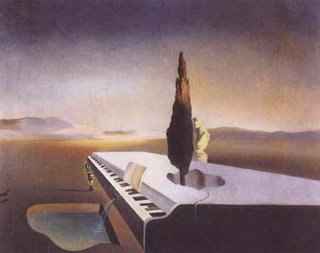 Critics who take the artist at face value often miss the point. Artists love to freak out the squares and critics are seen as Buffy’s Mother (that would be Joyce) – suburban and mediocre. Critics over time generally denounce Dali for this picture “Necrophilic Fountain Flowing from a Grand Piano” (1933). This is a masterpiece. It brings the grand piano to perfect balance – the Tree of Life grows from it and the curing waters of Aquarius flow from it. The grand piano here has dual nature; one on the earth and a second piano image below made of water (the unconscious).
Critics who take the artist at face value often miss the point. Artists love to freak out the squares and critics are seen as Buffy’s Mother (that would be Joyce) – suburban and mediocre. Critics over time generally denounce Dali for this picture “Necrophilic Fountain Flowing from a Grand Piano” (1933). This is a masterpiece. It brings the grand piano to perfect balance – the Tree of Life grows from it and the curing waters of Aquarius flow from it. The grand piano here has dual nature; one on the earth and a second piano image below made of water (the unconscious).
 Dali’s “The Invisible Harp,” (1934) - here is the grand piano clearly in the land of the Unconscious with its dark “Traveler” – he who lives on the dark side of human experience and brings us gifts from the Unconscious – the Cosmic Self. There are other
Dali’s “The Invisible Harp,” (1934) - here is the grand piano clearly in the land of the Unconscious with its dark “Traveler” – he who lives on the dark side of human experience and brings us gifts from the Unconscious – the Cosmic Self. There are other grand piano pictures but they begin to lose their dense unconscious quality in 1934.
grand piano pictures but they begin to lose their dense unconscious quality in 1934.
Pegasus arrives in the sky in 1944 (Untitled - Dali).
And in the same year (1944) the grand piano makes its way through the curtain in Dali’s “The Red Orchestra,”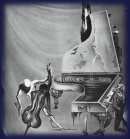 finding its way out of the unconscious and into every day life.
finding its way out of the unconscious and into every day life.
Here is “Red Orchestra” again in 1957, the  same year he painted “Rock and Roll” and actually tried to market a perfume with the name Dali’s Rock and Roll. The piano here is white (and timeless, like ancient ruins) and has emerged from the curtain (the Unconscious) and the curing waters of psyche flow from it as from the tomb in “William Tell” and live in it. The color red suggest the passage from the Unconscious to the world is complete.
same year he painted “Rock and Roll” and actually tried to market a perfume with the name Dali’s Rock and Roll. The piano here is white (and timeless, like ancient ruins) and has emerged from the curtain (the Unconscious) and the curing waters of psyche flow from it as from the tomb in “William Tell” and live in it. The color red suggest the passage from the Unconscious to the world is complete.
The Shadow/Self figure above in “The Invisible Harp” appears with Magritte as well and many of these images appear in both Magritte and Dali, but Magritte’s picture seem to simply state the archetype, while Dali’s dance the Unconscious dance, like Krishna’s dance of “life and death.” Here is Magritte’s alchemic lion on a bridge between millennia with its magnificent Dark Aspect.
 This is Rene Magritte’s “Homesickness” – 1941. Magritte makes the journey with Dali, but longs for home all the way. It is the same with Lennon and McCartney – Lennon continually presses the journey Across the Universe, while McCartney well complements his voice and vision and goes along, but throughout, he desires to find the Long and
This is Rene Magritte’s “Homesickness” – 1941. Magritte makes the journey with Dali, but longs for home all the way. It is the same with Lennon and McCartney – Lennon continually presses the journey Across the Universe, while McCartney well complements his voice and vision and goes along, but throughout, he desires to find the Long and
For Dali, the bridge to Aquarius is crossed and here is the Aquarian. This painting is called “The Second Coming of Christ,” painted in 1971. The alchemical feature of the double dragon seems applied (from Jung’s studies), but in the sky Pegasus, the Aquarian harbinger, is pierced and is passed through. He disappears into the clouds. The avatar is a Buddhist monk with hermaphrodite features, suggesting transition from yin age to yang age.
painting is called “The Second Coming of Christ,” painted in 1971. The alchemical feature of the double dragon seems applied (from Jung’s studies), but in the sky Pegasus, the Aquarian harbinger, is pierced and is passed through. He disappears into the clouds. The avatar is a Buddhist monk with hermaphrodite features, suggesting transition from yin age to yang age.
And here is Magritte’s grand piano:
 Magritte’s The Happy Hand (1953). Magritte’s piano is ringed in a perfect circle, the sign of psychic wholeness. Yet it has a Shadow, a reflection on the glossy top of the piano suggesting that the circle can be broken.
Magritte’s The Happy Hand (1953). Magritte’s piano is ringed in a perfect circle, the sign of psychic wholeness. Yet it has a Shadow, a reflection on the glossy top of the piano suggesting that the circle can be broken.
 The white grand piano that became the icon for John Lennon’s last moment in public life and the very last end of The Beatles and Lennon’s public life journey. The white grand piano has become a talisman for the song “Imagine,” Lennon’s swan song. At an impromptu TV memorial for the victims of 9/11 featuring popular artists and musicians such as Tom Hanks, Bruce Springsteen, Bono and U2 and Robert DeNiro, the centerpiece event was Neil Young singing Imagine on a white grand piano. The song Imagine takes its theme from Tolstoy’s late work on pacifism and religion. Lennon’s final impression was: Imagine there’s no heaven, it’s easy if you can, no hell below us, a brotherhood of man. This is precisely
The white grand piano that became the icon for John Lennon’s last moment in public life and the very last end of The Beatles and Lennon’s public life journey. The white grand piano has become a talisman for the song “Imagine,” Lennon’s swan song. At an impromptu TV memorial for the victims of 9/11 featuring popular artists and musicians such as Tom Hanks, Bruce Springsteen, Bono and U2 and Robert DeNiro, the centerpiece event was Neil Young singing Imagine on a white grand piano. The song Imagine takes its theme from Tolstoy’s late work on pacifism and religion. Lennon’s final impression was: Imagine there’s no heaven, it’s easy if you can, no hell below us, a brotherhood of man. This is precisely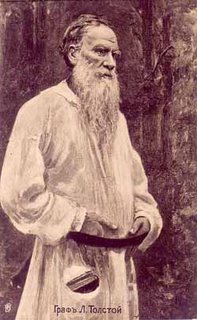 Tolstoy’s religious conviction at the end of his life. He advocated abandoning identity with a particular prophet as one would abandon nationalism. In one of his last writings on the subject Tolstoy clearly states his opinion: “Attributing a prophetic mission peculiar to certain beings such as Moses, Christ, Krishna, Buddha, Muhammad, Haha’u’llah as well as several others is one of the major causes of division and hatred between men.” Imagine also owes to The Gospel of Thomas (as do other of Lennon’s bits from late Beatles – The White Album). Elaine Pagel’s book Beyond Belief: The Secret Gospel of Thomas states that in Thomas’s account, Jesus challenges those who mistake the kingdom of God for an otherworldly place or a future event: Jesus said, “If those who lead you say to you, Look, the kingdom is in the sky,’ then the birds of the sky will get there before you . . .” In other words, Imagine there’s no heaven. (It is interesting that this makes the Christ’s view confluent with the Torah of Moses, Eastern Orthodox (Chronos) and zen.)
Tolstoy’s religious conviction at the end of his life. He advocated abandoning identity with a particular prophet as one would abandon nationalism. In one of his last writings on the subject Tolstoy clearly states his opinion: “Attributing a prophetic mission peculiar to certain beings such as Moses, Christ, Krishna, Buddha, Muhammad, Haha’u’llah as well as several others is one of the major causes of division and hatred between men.” Imagine also owes to The Gospel of Thomas (as do other of Lennon’s bits from late Beatles – The White Album). Elaine Pagel’s book Beyond Belief: The Secret Gospel of Thomas states that in Thomas’s account, Jesus challenges those who mistake the kingdom of God for an otherworldly place or a future event: Jesus said, “If those who lead you say to you, Look, the kingdom is in the sky,’ then the birds of the sky will get there before you . . .” In other words, Imagine there’s no heaven. (It is interesting that this makes the Christ’s view confluent with the Torah of Moses, Eastern Orthodox (Chronos) and zen.)
 This is the so-called Piano Man in the British mental hospital who appeared to the world out of nowhere in April, this year. He spoke not but drew pictures of a grand piano and played snippets of John Lennon and classical music. His drawing (at the top of this essay), like Magritte’s, has a shadow and it is contained in a completed circle. Has anyone studied the content of this man’s images? Perhaps he like Lennon, Dali and Magritte has had visions of the Unconscious and they proved to be too much for him. William Butler Yeats said, “What portion in the world can the artist have/Who has awakened from the common dream/But dissipation and despair?”
This is the so-called Piano Man in the British mental hospital who appeared to the world out of nowhere in April, this year. He spoke not but drew pictures of a grand piano and played snippets of John Lennon and classical music. His drawing (at the top of this essay), like Magritte’s, has a shadow and it is contained in a completed circle. Has anyone studied the content of this man’s images? Perhaps he like Lennon, Dali and Magritte has had visions of the Unconscious and they proved to be too much for him. William Butler Yeats said, “What portion in the world can the artist have/Who has awakened from the common dream/But dissipation and despair?”
After Piano Man had been silent in the mental hospital for several months, a nurse came in and said, “Well, are you going to speak this morning.”
“I think I will,” he answered. He said he was from
“It was the first thing to pop into my head,” he said.
 Into the Occult – In 1964, not long after a religious conversion, Dali painted a vision of a Cosmic John (Untitled [St. John], 1964). He drew it again, this time from the rear, in 1965, a few years before his painting of the Christ as an Orange Monk. It is worth noting that both Dali’s work then and
Into the Occult – In 1964, not long after a religious conversion, Dali painted a vision of a Cosmic John (Untitled [St. John], 1964). He drew it again, this time from the rear, in 1965, a few years before his painting of the Christ as an Orange Monk. It is worth noting that both Dali’s work then and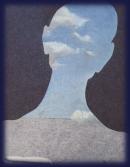
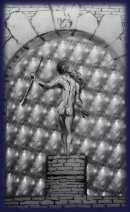 the clouds on the famous Imagine album (photo by Yoko Ono). Magritte’s well-known painting Son of Man ( 1964) – an Englishman with an apple for a face – certainly suggests the Savior, as the text from the Book of Daniel is a direct reference to the Chosen One*. But in this case, the Chosen One is
the clouds on the famous Imagine album (photo by Yoko Ono). Magritte’s well-known painting Son of Man ( 1964) – an Englishman with an apple for a face – certainly suggests the Savior, as the text from the Book of Daniel is a direct reference to the Chosen One*. But in this case, the Chosen One is identified by a green apple – which became the emblem of The Beatles in their middle period (Apple Records). This appears within the realm of the possible in Dali as well. In Living Still Life, 1956, the major elements of the central composition can be seen (as in the slightly modified illustration at the bottom) as the table, the grail and instead of a Host, which represents the Christ at the Sacrifice of the Mass, a green
identified by a green apple – which became the emblem of The Beatles in their middle period (Apple Records). This appears within the realm of the possible in Dali as well. In Living Still Life, 1956, the major elements of the central composition can be seen (as in the slightly modified illustration at the bottom) as the table, the grail and instead of a Host, which represents the Christ at the Sacrifice of the Mass, a green apple. In this picture, like many of Dali's, I get the feeling that he is sincerely following the dream or vision, then throwing in extra elements to obscure the essential theme. It is like the Magritte’s suggested something perhaps of the occult related to The Beatles, who came into their arc of creativity from 1963 to 1968. Commentators have noticed that Dali’s Man with His Head Full of Clouds (1936) looks like a “negative image painting” (something from the Unconscious, not yet manifest) and it has reminded them of John Lennon with his head in I Spy children's books, and not far from The Beatles with the Sgt. Peppers cover. They said they put in pictures of people they really admired, then a lot of people they didn't like at all. (This grail item works through Dali's work as a "dual nature" devise - suggesting two natures; the one earth-bound, the other cosmic.) Lennon and his wife Yoko Ono knew Dali and met with him in
apple. In this picture, like many of Dali's, I get the feeling that he is sincerely following the dream or vision, then throwing in extra elements to obscure the essential theme. It is like the Magritte’s suggested something perhaps of the occult related to The Beatles, who came into their arc of creativity from 1963 to 1968. Commentators have noticed that Dali’s Man with His Head Full of Clouds (1936) looks like a “negative image painting” (something from the Unconscious, not yet manifest) and it has reminded them of John Lennon with his head in I Spy children's books, and not far from The Beatles with the Sgt. Peppers cover. They said they put in pictures of people they really admired, then a lot of people they didn't like at all. (This grail item works through Dali's work as a "dual nature" devise - suggesting two natures; the one earth-bound, the other cosmic.) Lennon and his wife Yoko Ono knew Dali and met with him in  after their wedding at
after their wedding at  demurred.
demurred.
*from the Catholic Encyclopedia: In the great vision of Daniel
 The Lion of God . . . I’ve never particularly cared for the C.S. Lewis stories. Was the prose in which I could not become entangled – felt it was an analytical approach to the alchemy of the human soul with a guided exit (Alchemy for Optimists). You always knew the conclusion ahead of time, like with Christian rock bands. Also I considered that it was his
The Lion of God . . . I’ve never particularly cared for the C.S. Lewis stories. Was the prose in which I could not become entangled – felt it was an analytical approach to the alchemy of the human soul with a guided exit (Alchemy for Optimists). You always knew the conclusion ahead of time, like with Christian rock bands. Also I considered that it was his  To note: in Hinduism, the Buddha is an incarnation of Mahavishnu, one of the gods of the Hindu Trinity, identified as a lion man. Worth recalling the words and vision of Padmasambhava, the founder of the oldest of the four schools of Tibetan Buddhism, written twelve hundred years ago: When the iron bird flies and the iron horse rolls on wheels, the Tibetan people will be scattered like ants across the face of the earth, and the teachings of the Buddha will come to the land of the red-faced people.
To note: in Hinduism, the Buddha is an incarnation of Mahavishnu, one of the gods of the Hindu Trinity, identified as a lion man. Worth recalling the words and vision of Padmasambhava, the founder of the oldest of the four schools of Tibetan Buddhism, written twelve hundred years ago: When the iron bird flies and the iron horse rolls on wheels, the Tibetan people will be scattered like ants across the face of the earth, and the teachings of the Buddha will come to the land of the red-faced people.
No comments:
Post a Comment